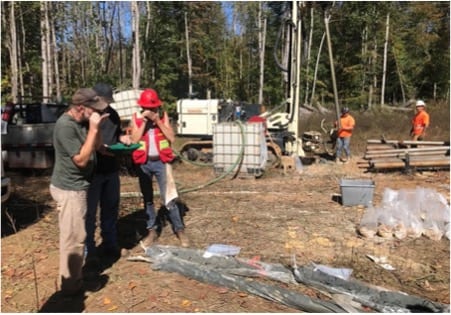All Maiden Drill Holes Hit Elevated HMS Mineralisation
Tao Commodities Limited (ASX: TAO) believes it is on the track of a world-scale, high grade U.S. Heavy Mineral Sand (HMS) after its maiden drilling programme at the Titan Project in west Tennessee.
The 15 hole programme intersected thick, high grade mineralisation in drill holes completed in the Phase 1 drilling programme, with a valuable mineral assemblage in drill holes selected for analysis.
Executive Director, Taso Arima, said all Phase 1 sonic core holes encountered zones with elevated HMS mineralisation. Within the Phase 1 programme, the thickest and highest-grade results were obtained from the company’s northern most properties following a ridge line where 12 holes intersected thick zones of mineralisation. This thick zone of mineralisation ranged from 12.2 to 48.8 meters with all results >1.0% THM and with
Highlights have included: 47.2m @ 3.69% THM, including 10.7m @ 8.09% THM and 10.7m @ 5.47% THM; 35.1m @ 3.04% THM, including 10.7m @ 8.16% THM; and 32.0m @ 3.12% THM including 10.7m @ 5.64% THM.
“We are very encouraged by these initial results and plan to aggressively delineate this potentially world scale HMS deposit which has exceptional characteristics including; simple geology, high grade intersections, high value assemblage, located in an infrastructure rich, low cost region in the USA with customers on our doorstep,” Mr Arima said.
Within this thick envelope of mineralization, two zones of high-grade mineralisation have been recognised, and are described as an Upper Shore Zone (USZ) and a Lower Shore Zone (LSZ).
Three holes were completed in the land package located just west of Camden, Tennessee, and encountered thick zones of lower grade mineralisation compared to the results seen in the northern properties, with the mineralisation hosted in the lower member of the McNairy Sand.
The Phase 1 drill programme utilised a sonic drill rig, which allowed for core samples to be taken every ~1.5 meters (5 ft). These samples were then bagged and shipped to SGS Laboratories in Lakefield, Ontario, where a Heavy Mineral Concentrate (HMC) was prepared.
The HMC was prepared via screening for oversize (+600 microns) and slimes (-45 microns) and then subjecting an 85-gram sub-sample from the screened fraction to heavy liquid separation at 2.95 specific gravity. Weights were recorded for the HMC, oversize fraction (+600 microns) and the slimes (-45 microns) for each sample. The Total Heavy Mineral (THM) percentage was then calculated by including the mass of the oversize material and the slimes.
Subsequent to the THM interpretation, 70 select HMC samples from 4 drill holes were sent to SGS Lakefield and subjected to QEMSCAN analysis to determine the mineral assemblage within the HMC. Valuable Heavy Minerals (VHM) assemblage was derived from the HMC samples by adding the rutile, leucoxene, pseudorutile /Hi-Ti Ilmenite, ilmenite, Ti- magnetite/hematite, zircon and monazite (rare earths). This calculation excludes quartz, staurolite, kyanite and all other non-valuable minerals.
The initial results highlight a favourable VHM range of 42% – 76% across the selected drill holes.
Particularly encouraging are initial indications of a highly valuable potential product suite within the VHM portion of the THM comprising of large proportions of rutile (16.9%) and zircon (14.5%) with the majority of the remaining VHM being titanium minerals including leucoxene and pseudorutile with minor amounts of ilmenite and titanium magnetite/hematite.












